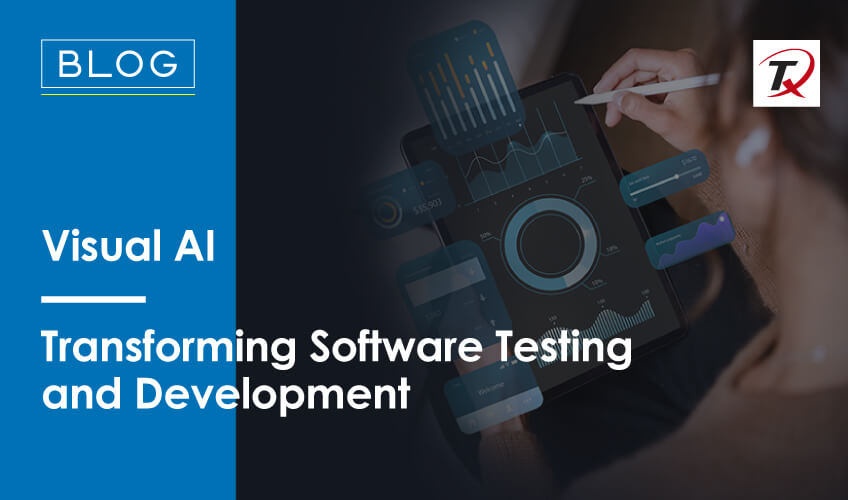- What is Visual AI? Why Does it Matter?
- Visual AI vs Computer Vision
- Business Use Cases of Visual AI
- How does Visual AI Transform Software Testing and Development?
- Why Partner with Tx for Quality Engineering Services?
- Summary
Imagine a scenario where computers interpret and understand the visual world just like humans do and an ecosystem where videos and images are rich data sources. What outcomes and the type of insights and possibilities will it unlock? From upscaling healthcare diagnostics to improving retail CX, visual AI, data, and AI services are transforming the world around us. This technology is an indispensable solution for enhancing productivity and efficiency in software development and testing. According to statistics, developers using AI tools increased their coding output, reporting a 126% boost in weekly project completions. Also, the AI market of visual and generative AI is experiencing exponential growth, with AI-based software market value reaching $251 billion by 2027.
73% of US-based companies already use AI in some areas, focusing on generative AI for handling modern business practices. Integrating visual AI in software development and testing paves the way for more efficient, reliable, and intelligent software solutions. Visual AI is not a buzzword; it is scientific evidence behind machines’ ability to decipher and interpret the visual ecosystem like humans.
What is Visual AI? Why Does it Matter?
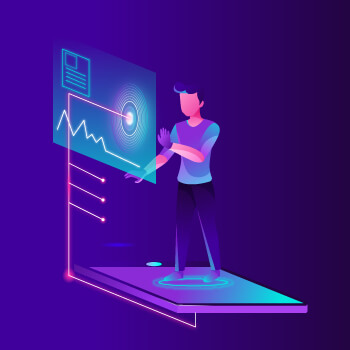
Visual AI is an application of AI that enables computers to comprehend and interpret visual content such as videos and images. This technology works similarly to human vision. In other words, visual AI gives the software a pair of eyes to perceive the world with them. It is a smart technology that understands how and when what it perceives is per humans and to make better decisions. It leverages deep learning models to analyze videos and images, which makes it possible for businesses to automate tasks requiring visual cognition.
Visual AI also uses ML algorithms to process visual data, as these algorithms are trained using large datasets of videos or images. It can perform various tasks such as facial recognition for security systems, object recognition, defect detection, etc. According to statistics, the AI image recognition market is expected to cross the $10 billion milestone by 2028. Let’s take a close look at why it is so important:
• It automates and enhances tasks that previously required human inspection, such as manufacturing quality control and retail inventory management. This helps reduce errors and improve efficiency.
• It can help visually impaired users in digital environments navigate more independently using real-time image and text recognition technologies.
• In healthcare, this technology is often used for accurate and fast analysis. For instance, visual AI assists in disease diagnostics by utilizing medical imaging with higher precision.
• Visual AI technologies like AR enhance the shopping experience in the retail sector by enabling users to try products virtually.
• It assists in improving security systems by facilitating real-time and accurate facial recognition and anomaly detection in video surveillance footage.
Visual AI vs Computer Vision
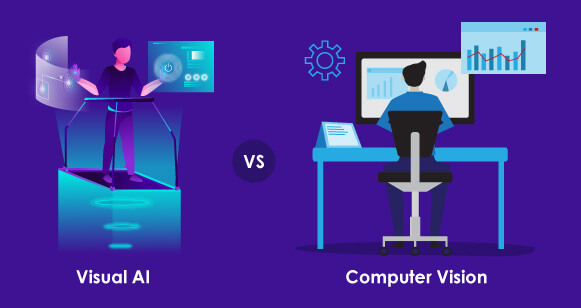
Aspects |
Visual AI |
Computer Vision |
| Definition | Leverage ML to interpret and act on visual data. |
Focus on acquiring, processing, and analyzing visual data to understand it. |
|
Technology |
Utilize advanced ML algorithms that include deep learning to analyze videos or images. | Utilize various algos and techniques to process and analyze visual data without understanding it. |
| Applications | Found in autonomous vehicles, healthcare diagnostics, customer service, etc. | Used in industrial automation, quality control, simple identification tasks, and surveillance. |
| Learning Capability | Continuously learns and improves from new data and adjusts its response. | Usually, it operates according to pre-defined rules without an ongoing learning process. |
| Complexity | Complex model requiring significant computational power and data. | It has low complexity and can work on limited data and simple algorithms. |
| Outcome | Understand and predict outcomes on visual inputs. | Recognizes and interprets visual data without predicting future stats. |
| User Interaction | Designed to interact with users, providing dynamic responses based on visual inputs. |
Usually do not interact directly with users but process visual data for other applications. |
Business Use Cases of Visual AI
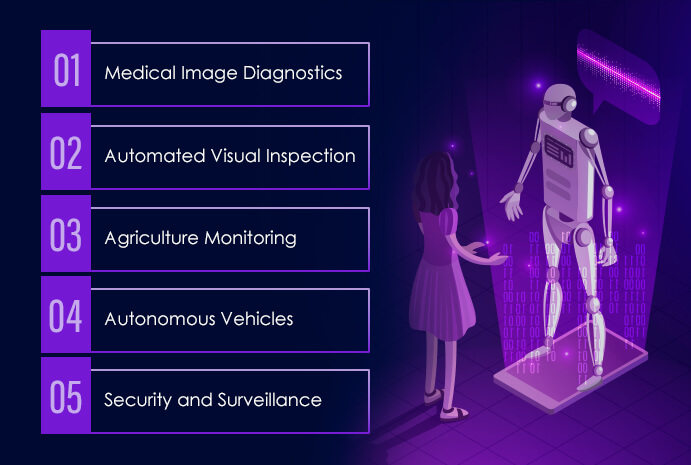
Manufacturing, automobiles, and law enforcement are examples of innovative uses of visual AI. It offers solutions to enhance efficiency, improve CX, and ensure consistency in business-critical operations. As businesses integrate AI within their workflow, visual AI will lead to transformative outcomes across various industries.
Medical Image Diagnostics:
In the healthcare industry, visual AI allows doctors to diagnose medical conditions by analyzing medical images from various sources, such as X-rays, CT scans, and MRIs. It can detect abnormalities in medical images, which allows radiologists to identify potential health issues quickly and accurately, thus also assisting in treatment planning.
Automated Visual Inspection:
In manufacturing, factories use visual AI technology to inspect items on production lines. Its analytics algorithms can detect variations and irregularities in everything from automotive parts and electronics to garments and textiles. No matter how small the problem, visual AI can improve quality control in many ways. This eventually allows businesses to cut costs and overheads.
Agriculture Monitoring:
This technology assists in monitoring crop health and optimizing pesticide distribution in the agriculture sector. Drones with visual AI technology analyze fields to identify pest infestations, assess crop health, and predict climate changes, enabling better crop management and precise pesticide application.
Autonomous Vehicles:
Visual AI assists in developing autonomous vehicles so that they can perceive and interpret what’s going on around them. Vehicles have cameras mounted on them to capture surrounding images. Visual AI processes those images to identify other vehicles, traffic signals/signs, lane markings, pedestrians, etc. The end goal is to facilitate safe driving and navigation capabilities. For instance, Tesla’s Autopilot utilizes cameras and radar for braking and lane changing. On the other hand, Waymo’s taxis navigate urban environments by identifying pedestrians.
Security and Surveillance:
Visual AI facilitates precise facial recognition and behavioral analysis capabilities. It takes surveillance and security to another level. Retail environments, Airports, government buildings, and public spaces all utilize visual AI solutions to improve surveillance systems capabilities. Visual AI assists these systems in issuing intervention alerts when problematic behavior and body language is detected or if a person has been seen in an off-limit area.
How does Visual AI Transform Software Testing and Development?
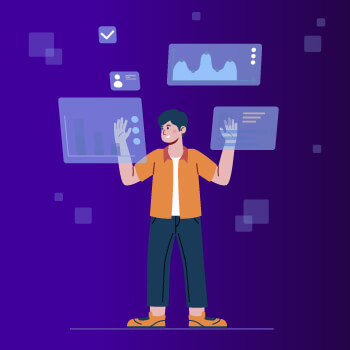
Traditional QA methodologies for software testing involve a high ratio of manual testing. Even with automated testing practices, validating the entire digital business environment with functional, visual, and cross-browser testing is difficult. Without a proper validation method, automation engineers must write cumbersome locators and complex assertions for each element under test. Even after doing all this, the QA team has to spend a lot of screen time to ensure no bugs occur in the latest release. They must do this for every browser, device user uses, and every platform their software works on.
On the other hand, software development is becoming more complex each day. Apps have more pages to evaluate, need to be faster, and must offer continuous releases, which also needs testing. The result? Tens or hundreds of screen hours to develop and test. Traditional testing cannot meet this demand. Businesses using traditional methodologies must slow down releases or decrease test coverage area.
Visual AI is transforming software development and testing today. Businesses can greatly improve their accuracy rate by training AI on billions of images and using numerous AI/ML algorithms.
By utilizing visual AI, they can achieve highly scalable automated testing regardless of the number of browsers or pages needing testing. Automation engineering can quickly take snapshots, and visual AI can analyze them rather than writing endless assertions.
Also, manual testers only have to evaluate issues that visual AI delivers to them rather than analyze every test case. In return, businesses can deliver better quality software faster and improve customer experience. Additionally, visual AI tools can enhance traditional debugging by visually representing complex code execution and dataset flows. This makes it easier for developers to understand their app’s behavior and pinpoint error sources effectively.
Why Partner with Tx for Quality Engineering Services?

Partnering with Tx for quality engineering services ensures access to cutting-edge AI technologies that can help transform your software development and testing into more accurate, innovative, and efficient processes. We leverage advanced AI solutions in our testing process to reduce errors and speed up time-to-market for your software products. This strategic tech integration makes Tx an ideal partner for businesses wanting to stay ahead in the changing digital age.
Our in-house accelerator, Tx-SmarTest, is an AI-enabled platform that supports faster releases through DevOps CI/CD processes. It can boost your software quality through production enabled by combining AI/ML, Deep Learning, and neural network algorithms. It serves as a smart assistant that automates numerous repetitive tasks efficiently. By partnering with us, you can significantly reduce the need for time-consuming manual testing, enabling your teams to focus on more complex tasks and develop innovative features.
Summary
Visual AI is transforming various industries by enabling computers to interpret and understand visual data similarly to human vision. This technology enhances efficiency and productivity in healthcare, retail, and manufacturing by automating tasks requiring visual cognition. In software development and testing, it automates the validation of visual elements, reducing manual effort and increasing accuracy, which facilitates faster and more reliable software delivery. Contact our experts now to find out how Tx can help you elevate your software QA process.
The post Visual AI: Transforming Software Testing and Development first appeared on TestingXperts.

